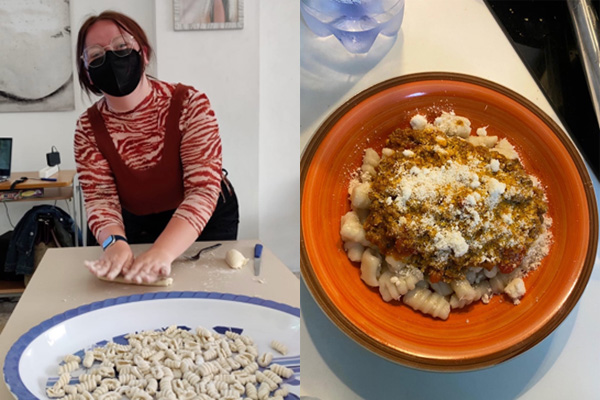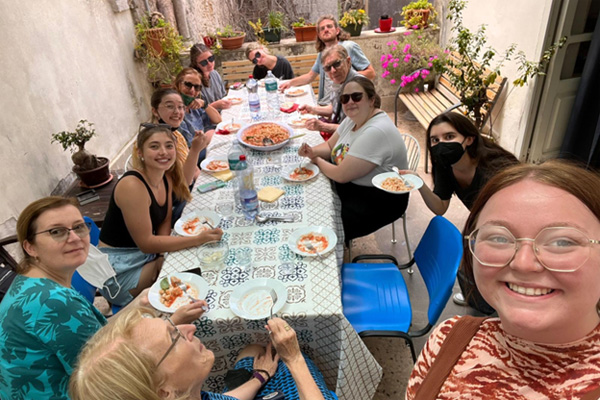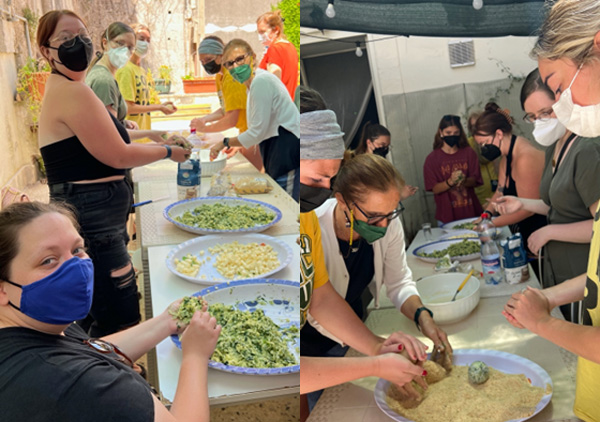 Emily McCarty making cavateddi and the final dish, Cavateddi al Ragù.
Emily McCarty making cavateddi and the final dish, Cavateddi al Ragù.Students interested in the Food in Sicily study away program, scheduled for May 10-31, 2023, are invited to attend an upcoming information session on Microsoft Teams.
Participants in the study abroad experience can earn six Ohio University credits, learn about the culture of food in Sicily, and get hands-on experience tasting and making Sicilian dishes.
“Like ice cream, cheesecake, and chocolate? What about marzipan, cannoli, and sumptuous pasta? Then, come experience the cultural and historic food ways of Sicily, the Mediterranean’s largest island. We’ll travel Sicily’s eastern ‘Greek’ coast to see and taste this unique island’s rich history of food traditions. You may even meet the Chef’s Table star while visiting Caffè Sicilia in Noto, Sicily,” said Food in Sicily Director David Bell, Ph.D., chair and associate professor of linguistics in the College of Arts and Sciences.
Interested students are invited to join an information session via Teams at one of the following dates and times:
- Wednesday, Jan. 18, at 7:30 p.m.
- Tuesday, Jan. 24, at 7:30 p.m.
- Thursday, Feb. 2, at 7:30 p.m.
- Monday, Feb. 6, at 7:30 p.m.
- Wednesday, Feb. 16, at 7:30 p.m.
- Tuesday, Feb. 21, at 7:30 p.m.
- Monday, Feb. 27, at 7:30 p.m.
Students Learn How to Make Sicilian Dishes
In addition to learning about wine, olive oil, chocolate, and cheese, one of the many activities on the Food in Sicily program is cooking. Students in will learn how to make two traditional Italian dishes: cavateddi al ragù and arancini.
Making Cavateddi al Ragù
Cavateddi al ragù is made from cavati, or cavateddi in Sicilian, and tomato sauce. During a recent Food in Sicily program, students gathered at the Exedra Center in the heart of Ortigia to make the pasta.
“The point is to show how the simplest of ingredients — flour and water — can be turned into something delicious and nutritious. This is the essence of cucina povera, the cuisine of the poor,” said Theresa Moran, a Food in Sicily faculty member.
The students were led in the pasta making experience by Exedra staff member Sefi Monterosso, who showed the students how to make a mound of flour and with judicious drops of water, turn it into a dough, then start to roll and knead it. Students watched Monterosso expertly gather up a ball of dough in her hands and then slam it down onto the kitchen table.
“This a great way to get rid of all your frustrations and anxieties,” Monterosso said as she pounded the ball of pasta onto the table, kneading it with the heel of her hand, lifting it, and then hurling it back down on the table. “This is also necessary to build up the gluten so the pasta isn’t flabby,” she said.
After lots of kneading, when the dough was smooth, soft and very slightly puffy, the students started rolling out the pasta. They first cut the dough and then rolled pieces of it out into worms or snakes. Then, they cut the dough snake into shorter pieces, using the knuckle on their thumb as a rough measure. Taking a fork, the students quickly rolled the small pieces one by one down the the tines on the back of the fork, gathering them into awaiting platters. The short pieces of dough end up making a shape vaguely resembling a pill, roly-poly, or potato bug.
For Monterosso and the other Sicilian staff, who have been making this pasta for years, each little piece of dough is lightly, quickly and efficiently pressed down the back of the fork and with a flick of the wrist, sent onto the platters. Students often press the dough too hard, and the pasta then doesn’t curl and becomes too deeply grooved.
After the students finished making the cavateddi, they tossed the pasta briefly with flour to keep the individual pieces from sticking. The pasta was then dropped into a large cauldron of boiling water and boiled briefly.
When the pasta pops up to the surface of the water, it’s time to drain and dress the pasta. First, the pasta is tossed with a little extra virgin olive oil and then the dish is dressed with a plain red sauce made from local tomatoes. Here is where the grooves from the fork tines are important—the sauce clings to the individual grooves in each piece of pasta. Matching the right pasta shape to the right type of sauce is an essential part of Italian cooking, and the cavateddi go perfectly with the simple sauce of local tomatoes, garlic, parsley, and chilies, Moran noted.
For the final touch, the students sprinkled the pasta with grated cheese. Usually ricotta salata, a typical hard Sicilian cheese, made from fresh ricotta cheese that is pressed, salted, dried, and aged for 30 days or more, is used, Moran added.
Making Arancini
Arancini are rice balls, one of the most common Sicilian street food snacks eaten at any time of the day. The singular form is arancino, a diminutive of the word arancia, which means “orange,” derived from the classical Arabic word for orange, naranj. Arancini, also known in Rome as supplì, is a dish that can be traced back to the Arab conquest of Sicily. These rice balls can be filled with cheese, meat and peas in red sauce, ham, mushrooms, zucchini, and even with a sweet filling such as a pistachio cream.
Arancini also signify an important cultural rivalry between the western Arab influenced part of the island and the eastern Greek influenced part. In Palermo, in western Italy, the rice balls are often shaped like oranges and are called arancine, using the feminine plural marker (arancina or arancinu in the singular). In Catania, in eastern Italy, often the rice balls are shaped into triangles like the Sicilian volcano Mount Etna, and their grammatical gender is masculine.
As with all cooking days at the Exedra Center, students in a recent Food in Sicily experience started by scrubbing their hands and forearms. Then large platters of steaming rice were brought out, and the students again learned from Monterosso and the other Exedra staff, for whom making these rice balls is part of their typical experience growing up in Sicily.
To make arancini, first make a small half dome ball in one palm and then carefully add the filling of choice in the middle of this ball. Fillings can be cubes of ham or cheese or a tablespoon of meat in red sauce. The idea is not to add too much filling — and not to have too much rice. Then place rice on top of the filling.
The students practiced cupping their hands together and pressing firmly to compact and shape the rice to the perfect shape.
After the rice ball is made, it’s quickly rolled in a thin flour slurry and then rolled in very fine breadcrumbs made from Sicilian bread. The arancini are then taken to the kitchen where they are deep-fried in a vat of olive oil. As soon as they are browned all over, they are removed and put out on towels to absorb the excess oil — and then eagerly grabbed as a delicious quick lunch or hot snack.
“The trick to eating arancini,” Moran said, “is waiting until they are just at the right temperature so that you can bite through the thin crispy rice shell into the delicious warm treat in the center.”
Food in Sicily Study Away Program
Food in Sicily is a faculty-led program for Ohio University credit. In OHIO study away programs, students earn OHIO credit, take courses with other OHIO students and are taught by OHIO faculty. A student’s financial aid package applies the same as it would for on-campus courses.
Food in Sicily is open to undergraduate and graduate students, and students can earn six credit hours while learning how to make mozzarella, practicing Italian with a “Table and Market” meeting with local social enterprises, helping with dinners at a local soup kitchen, taking cooking classes, and visiting farms, breweries and wineries. (For additional information see the articles on Singing, Dancing and Churning the Cheese in Sicily during the 2019 trip, and Food in Sicily students experience how service changes people’s lives and Food in Sicily students discover the power of community resilience during the 2022 trip).
Visits to markets and sites in Ortigia, Italy, include the Catacombs of San Giovanni, the medieval Jewish quarter and Castello Maniace. Day trips are planned to Catania, Italy, where students will visit the fish market, historic city center, Benedictine Monastery, Greek Theater and Cathedral. Students also will hike on Mt. Etna and enjoy time on Sicilian beaches, as well as tour the historical towns of Noto and Taormina
For more information, visit the Food in Sicily webpage or contact Bell at belld@ohio.edu.


